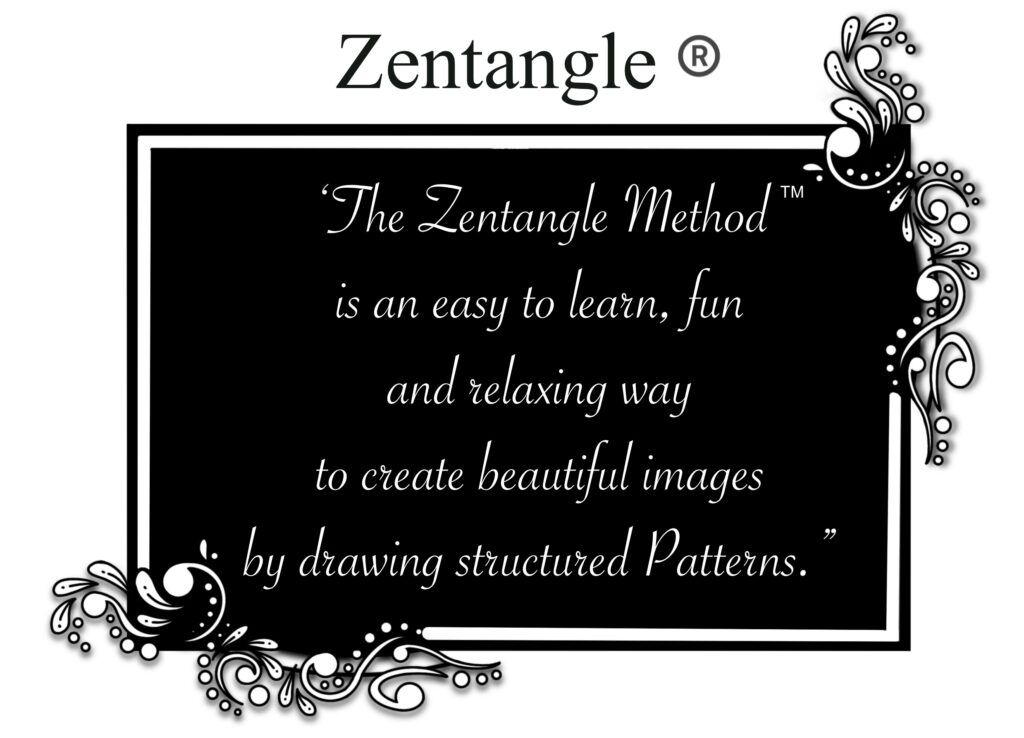
The best way to describe The Zentangle Method is to use the words of the founders – Maria Thomas and Rick Roberts:
“The Zentangle method is an easy to learn, fun and relaxing way to create beautiful images by drawing structured patterns.”
To read more about Zentangle and its origins visit zentangle.com
What is Zentangle?
If you look in the Miriam-Webster dictionary you will find the following definitions:
ZEN – “A state of calm attentiveness in which one’s actions are guided by intuition rather than by conscious effort.”
TANGLE – “To knit together in intricate confusion”
Put these together and you have a word that aptly describes the meditative creation of interwoven patterns.
Zentangle benefits
Its fun
Anyone can do it
Its relaxing
It has a supportive global community
Zentangle or Doodle?
The difference between Zentangle and doodling relates to what your mind is doing when creating marks on the paper. Doodling is something you do while your mind is on something else. A great example of this is the simple drawings or scribbles you create whilst talking on the phone. (Mindless)
Zentangle is the process of purposely creating patterns and designs. Your focus is solely on what you are drawing. (mindful)
Zentangle Pattern Steps
Zentangle has 8 basic steps
1. Gratitude and appreciation
Take the time to breathe and get comfortable before you begin. Gratitude puts us into a positive state of mind. You can simply appreciate the tools you are about to use or go deeper and find something else in your life that you feel grateful for. I personally like to think of something new each time I do this step. Gratitude helps you to experience more positive emotions and is associated with greater happiness.
2. Corner Dots
Use a graphite pencil to put a dot in each corner of your tile.
why? – you no longer have a blank piece of paper and don’t have to face the fear of that blank tile.
3. Border
Use a pencil to connect the four dots to create a border.
4. String
A string is a pencil line drawn lightly on your tile. This line can be any shape, it is simply a way of dividing the tile into sections in which we can draw our tangles. When I first started to tangle I was confused by these strings. They are just a guide, a way of dividing the page. You can even draw over them if you like… the pencil lines disappear once your tile is finished.
5. Tangle
The fun part! This is where we take a pen and draw our patterns or ‘tangles’
6. Shade
Shading is a magical way of bringing the tile to life. You can transform a 2D image into something that looks three dimensional. We do this by adding shades of grey with a graphite pencil. The shading can be blended and softened by using a paper blending stump or tortillion.
7. Initial and Sign
Celebrate your art by adding your initials to the tile. It’s also a great idea to sign and date the tile on the back. It may seem unimportant but it’s a great way of keeping track of your progress.
8. Appreciate
We started with appreciation and we also end with appreciation. Admire your work and appreciate what you have created.
Conclusion
The Zentangle method is something anyone can do by following simple steps. Established tangles have been created by Zentangle,inc as well as many talented CZT’s and tanglers across the globe. These tangles have been broken down into simple steps so that you can reproduce them. You don’t need to have any experience.
Start with basic tangling… white paper, black ink and shades of grey
Materials -3.5″ square paper or tile, graphite pencil (2B is a good pencil to use) and a blending stump or tortillion.
Zentangle art is non representational, portable and completeable.
Once you get the hang of it, you can then experiment with colour, different materials or even try some art that is Zentangle inspired. The main thing is… Have fun!


E não há erros no zentangle, apenas oportunidades…
That is so true Rosa!